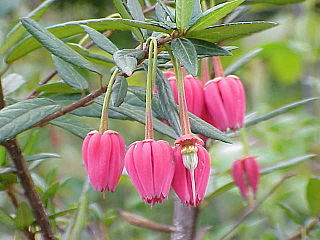
Mackerel is a common name applied to a number of different species of pelagic fish, mostly from the family Scombridae. They are found in both temperate and tropical seas, mostly living along the coast or offshore in the oceanic environment.

Herring are forage fish, mostly belonging to the family Clupeidae.

A booby is a seabird in the genus Sula, part of the family Sulidae. Boobies are closely related to the gannets (Morus), which were formerly included in Sula.

Elaeaocarpaceae is a family of flowering plants. The family contains approximately 615 species of trees and shrubs in 12 genera. The largest genera are Elaeocarpus, with about 350 species, and Sloanea, with about 120.

Morne Trois Pitons National Park is a national park in Dominica established in July 1975, the first to be legally established in the country. It became a World Heritage Site in 1997. The park is named after its highest mountain, Morne Trois Pitons, meaning mountain of three peaks. The park is an area of significant volcanic activity. Features within the park include the Valley of Desolation, a region of boiling mud ponds and small geysers; the Boiling Lake; Titou Gorge; and Emerald Pool. The mountain is the second-highest peak in Dominica, being exceeded only by Morne Diablotins.

A genet is a member of the genus Genetta, which consists of 14 to 17 species of small African carnivorans. The common genet is the only genet present in Europe and occurs in the Iberian Peninsula, Italy and France.
Sloanea acutiflora is a species of plant in the Elaeocarpaceae family. It is endemic to Suriname.

Sloanea is a genus of flowering plants in the family Elaeocarpaceae, comprising about 150 species.
Sloanea assamica is a species of plant in the Elaeocarpaceae family. It is found in Bhutan, China, India, and Myanmar.
Sloanea gracilis is a species of plant in the Elaeocarpaceae family. It is endemic to Suriname.
Sloanea lepida is a species of plant in the Elaeocarpaceae family. It is endemic to New Caledonia.
Sloanea suaveolens is a species of plant in the Elaeocarpaceae family. It is endemic to New Caledonia.
Sloanea tomentosa is a species of plant in the Elaeocarpaceae family. It is found in Bhutan, China, India, Myanmar, Nepal, and Thailand.
Bat Conservation International (BCI) is an international nongovernmental organization working to conserve bats and their habitats through conservation, education, and research efforts.

The Indochinese shrew is a species of white-toothed shrew native to Southeast Asia. It was first identified in 1922 by Herbert C. Robinson and C. Boden Kloss. The species is often taxonomized as a subspecies Horsfield's shrew, but bears a different range, occurring in Myanmar, Vietnam, and the Yunnan province of China. C. indochinensis is on the smaller end of shrews, with dark brownish gray fur and a long, slender tail.
Whitesloanea is a genus of flowering plants belonging to the family Apocynaceae. It has an unusual odor, in that many believe it to smell of fecal matter. Some have postulated that the center of the flower is actually meant to mimic an anal cavity.








